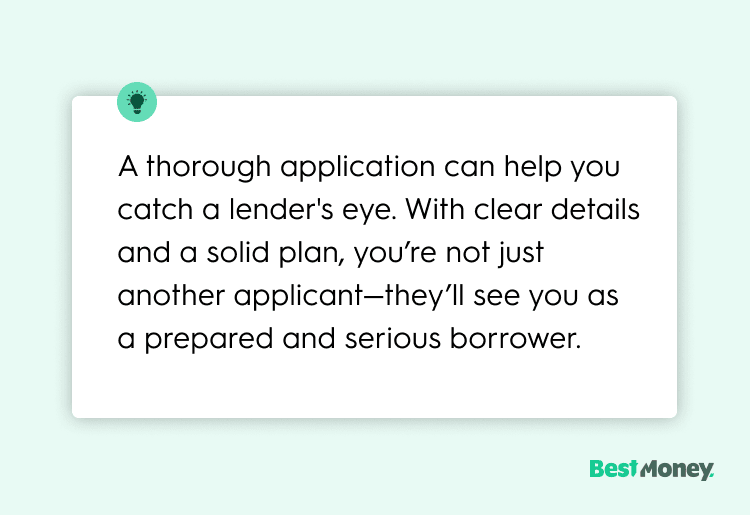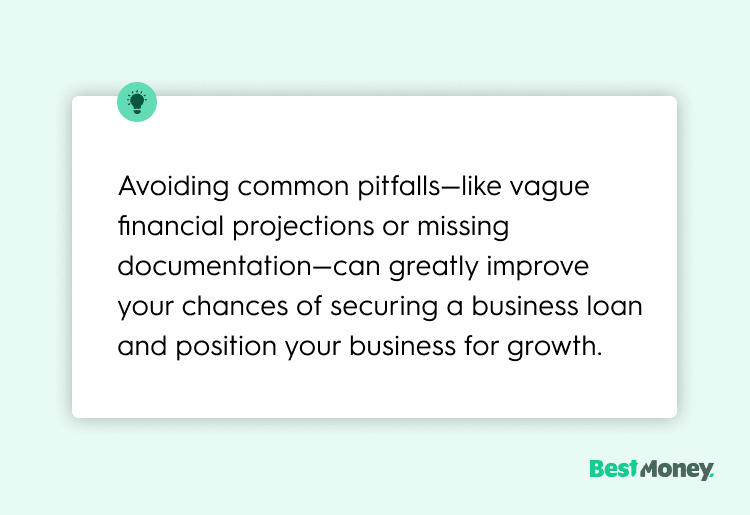
By presenting a detailed business plan, realistic financial projections, and a clear repayment strategy, you’re more likely to make a strong impression—one that could open the door to some of our best business loan lenders.
In this article, I’ve outlined the essential steps needed to prepare a solid application and avoid common pitfalls. I've also provided tips for making a compelling case to lenders.
Why a Strong Business Loan Application Matters
A strong application can improve your chances of securing a business loan as it shows lenders that you’ve done your homework, that you know your business inside out, and that you’ve got a solid grasp of where you fit in the market.
Increased chances of approval and better loan terms
A thorough application can help you catch a lender's eye. With clear details and a solid plan, you’re not just another applicant—they’ll see you as a prepared and serious borrower. This may lead to more favorable options, such as competitive interest rates or flexible repayment periods.
Faster review process
When your paperwork is in order, it saves everyone time. Lenders can quickly see that your finances are well-organized and that transparency makes it easier for them to assess your application. A faster decision can mean quicker access to the funds you need to move your business forward.

What Does a Successful Business Plan Include?
While each lender has unique requirements, most want to see a solid business plan as part of your loan application. A well-researched and organized plan demonstrates your commitment and careful consideration of various aspects of your business. Here’s a breakdown of the key elements your plan should cover:
1. Executive summaryThis is your chance to give a quick snapshot of your business. Include your mission statement, basic info about your leadership, and a brief summary of the rest of the plan. Keep it short—no more than one page. Think of it as the elevator pitch for your business.
2. Business descriptionDetail the structure of your business (e.g., LLC, C-corp, S-corp) and its history, location, and industry. This is also where you highlight what sets your business apart—like the problems you solve or your unique strengths.
3. Market and competitor analysisEven a strong business can struggle in the wrong market. Identify your target market and show evidence that there’s enough demand to support your business. Include insights into your competition: What are they doing well? How are you going to it do better? This shows lenders that your business has staying power.
4. Organization and managementLenders want to know who’s steering the ship. Outline your business’s organizational structure and introduce key leaders. Highlight their qualifications, and consider including resumes or CVs to show the experience they bring to the table.
5. Marketing and sales strategyMarketing and sales strategy sections of business plans are more fluid than other portions of the document because they evolve as your business's needs change. Based on your market analysis, explain how you plan to attract and retain customers.
You may also include details about actual sales within your business. What credit card processing does your business use? How long does it take for reimbursements?
6. Financial projectionsUse this section to paint a picture of your business’s financial future. The financial projections portion of your business plan should have projected income statements, cash flow statements, and balance sheets for the next three to five years. Be specific about the upcoming year, and use charts or graphs to back up your projections.
7. Funding requestClearly state how much funding you need and how you’ll use it. This is also where you outline your preferred loan terms—like the amount, repayment period, and interest rate. Show that you have a solid plan for repayment and how it fits into your broader business goals.
8. AppendicesThe appendices allow you to provide any supporting documents that help show the strength of your business. Standard documents in appendices are resumes, legal agreements, permits, market data, or any other documents lenders request.
What Lenders Look for In a Business Plan
When lenders assess your business loan application, they typically focus on the 5Cs of credit. These factors help them evaluate your creditworthiness and the likelihood of getting your money back. Here’s a breakdown of each:
1. CharacterLenders consider your credit history and your business's reputation when assessing your trustworthiness. They want to see a history of timely debt repayments and reliable management. If you’re a newer business, your personal credit history may weigh heavily here.
2. CapacityThe capacity valuation refers to the business's ability to repay the loan. Lenders analyze your cash flow and income to gauge your ability to make timely payments. A business with a steady income that exceeds expenses can present a strong case for loan approval.
3. CapitalLenders use this information to determine how much money business owners have invested in their company. Lenders like to see that you have “skin in the game,” as it shows you’re committed to making the business successful.
4. CollateralCollateral refers to any assets business owners can pledge to secure the loan, like real estate or equipment. Offering collateral helps to reduce the lender's risk and can positively influence the terms and size of the loan.
5. ConditionsThis covers factors outside your control, like the current state of the economy or industry trends. However, you can strengthen this aspect by clearly outlining how you plan to use the loan and staying resilient during market shifts.

Choose the Right Type of Loan for Your Business
When it comes to funding your business, the right loan depends on your needs, financial situation, and long-term goals. Different business loan types have unique advantages and disadvantages that you should carefully consider before committing. Here’s a look at some of the most common options and what they offer:
Term Loans
Term loans are the most common type of business loan. You get a lump sum upfront and pay it back, plus interest, over a set period. Payments are fixed, which makes budgeting easier, but interest rates can be on the higher side. Banks, credit unions, and online lenders all offer term loans.
SBA Loans
These loans are partially backed by the government, reducing the risk for lenders and potentially offering competitive terms, such as lower interest rates or longer repayment periods. Be prepared for a longer approval process and stricter requirements, but the payoff can be worth it.
Business Lines of Credit
Think of this as a credit card for your business. You can draw funds as needed, up to a set limit, and interest only accrues after you draw money and while it is repaid. It’s flexible, making it great for managing cash flow.
Equipment Loans
Need new machinery or tech? Equipment loans let you finance these purchases, with the equipment itself serving as collateral. This lowers the lender’s risk and often results in easier qualification and better terms.
Personal Loans for Business
If you’re a startup or don’t have a strong credit history yet, you can use a personal loan to fund your business venture. These loans don’t require a business plan or formal application, but approval is based solely on your personal credit.
How to Write a Compelling Loan Proposal
Tell Your Business’s Story Clearly and Confidently
Your loan proposal is your first opportunity to impress a lender, so it’s important to present your business’s history, current status, and future goals. Think of it as your written pitch—be clear, confident, and concise. Avoid jargon, and focus on giving a straightforward picture of your business.
Use Visuals to Enhance Your Financials
Charts and graphs can make a big difference in your proposal. They help illustrate your financial data, making it easier for lenders to understand and visualize your business's growth potential. Visual elements can help make your proposal clearer and more engaging for lenders.
Customize Your Proposal for Each Lender
Tailoring your content to meet each lender’s specific interests is key. For instance, if a lender prioritizes cash flow, emphasize your steady income streams. If they focus on industry experience, highlight your track record. This personalization shows that you understand their priorities and have done your homework.
Proofread Carefully
Before you submit your proposal, proofread it thoroughly—then proofread it again. Even minor errors can leave a bad impression. To ensure it’s error-free and polished, consider having a professional review your proposal. Your goal is to present your business in the best possible light.

Common Mistakes to Avoid in a Business Loan Application
Avoiding common pitfalls can help improve your chances when applying for a business loan. Here’s what to watch out for so you don’t hurt your chances of getting approved:
Incomplete application or missing documentation: Lenders want a complete view of your business’s financial health. Missing key documents or leaving sections blank can slow down the process—or even lead to an automatic rejection. Double-check that you’ve gathered everything they need before you submit.
Weak business plan: Your business plan is your blueprint. If it’s vague or poorly organized, it won’t inspire much confidence. Make sure it’s clear and detailed and gives lenders a solid understanding of your business’s potential.
Unrealistic financial projections: Lenders want to see a realistic picture of your business’s future. If your financial projections are overly optimistic or lack data to back them up, it can raise doubts about your credibility. Aim for numbers that reflect your business’s actual performance and growth prospects.
Poor credit management: While difficult, it is possible to get a business loan with bad credit
. Address any delinquencies or unresolved issues before applying, and be prepared to explain your credit history if needed.Vague loan purpose: Lenders need to know exactly how you’ll use the funds and how it will benefit your business. Be specific—whether the money is for expanding your space, buying new equipment, or boosting working capital, give a clear explanation.
Requesting the wrong amount: Asking for too much or too little can suggest poor planning. Lenders may question whether you've done your homework if the requested amount doesn’t match your business’s needs or your financial projections.
Poor communication: If a lender reaches out for more information or has questions, respond promptly and professionally. Being unresponsive can suggest disorganization, which isn’t a good look when you’re asking for funding.
Ignoring legal or regulatory considerations: Before applying, make sure you have all necessary permits, licenses, or other paperwork. Lenders expect you to be aware of industry rules, and missing these essentials can result in a quick denial.
Tips for Increasing Your Chances of Approval
You can do several things in your business loan application process to increase your chances of approval.
Prepare a strong business plan: Your business plan should contain a concise, clear executive summary, market analysis, financial projections, funding request, and all relevant documentation. Make sure your numbers are realistic and backed up with data—lenders often prefer conservative financial projections backed by realistic data.
Gather all required documentation: The more organized and thorough you are with your paperwork, the better. Gather cash flow statements, balance sheets, income statements, business licenses, registrations, and articles of incorporation. Well-organized documentation helps lenders see the full picture of your business’s financial health.
Showcase profitability: Use your application to emphasize your business’s ability to generate consistent revenue. Lenders want to know that your business can comfortably cover loan repayments, so clearly point out any strong revenue streams.
Choose the right loan type: Selecting a loan that most closely aligns with your business goals shows the lenders that you've done your research.
Outline a realistic repayment plan: Show lenders exactly how you plan to repay the loan, and include any safety nets or contingency plans you have in place. This reassures them that you’ve thought through the repayment process thoroughly.
Be honest: If your business has faced tough times, be upfront about it. Lenders appreciate transparency, especially when paired with a plan for how you’ve turned things around or a plan to manage future risks.
Avoid multiple applications: While it’s tempting to apply to many lenders to boost your chances, this can hurt your credit score. Instead, focus on a few key lenders that align with your needs and customize your application for each one.
Consult a professional: If you want to ensure the polish of your application, consider working with a professional. They can help present your business in the best possible light and navigate the application process with confidence.
Bottom Line
A well-prepared business loan application can enhance your presentation to lenders. While it doesn’t guarantee approval, a clear plan, realistic projections, and a thoughtful repayment strategy can strengthen your application. Focus on avoiding common pitfalls, and show that you’re ready to put new funding to good use—it's all about proving your business is ready for its next big step.
Remember, the effort you put into preparation now can pay off with better opportunities down the road. Present your business clearly and confidently, and you’ll be in a stronger position to secure the support you need to grow.








